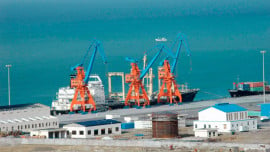
CPEC a ray of hope, says AJK President
Clearly, it seems that when it comes to infrastructure financing in Pakistan the role of private players seems to be missing and there is an inherent disconnect between what investors want and the wildly unpredictable way government does business in getting projects done.
Contrary to the popular practice, majority of infrastructure funding is still arranged through borrowing and Public-Private Partnership (PPP) models have not taken off despite a strong ‘push’ from the China-Pakistan Economic Corridor (CPEC).
So lots of super roads shall be built during the CPEC bubble but it is not clear whether building and levying tolls on new projects will help recover even project costs.
Case studies
High debts of acquiring land and construction in conflict-hit areas mean that there is little flexibility to cope when things go off plan. In fact, our national strategy towards infrastructure planning using PPP instruments is geared more towards the Mexican model.
Mexican government awarded more than 30 projects with $10 billion in private investments as part of its largest PPP toll road programme. It did not work out very well for anyone as there were cost overruns by 25% and revenue targets were not met.
Due to less than expected traffic density, the average road toll fee needed to be increased by seven fold. Eventually the government had to bail out and pay outstanding debt by taking over the majority of projects.
Similarly Hungary M1/M15 was the first motorway in Eastern Europe that was completed on time and within budget. It also falls prey to lower traffic volumes despite meticulous forecast prepared by independent consultants.
CPEC projects underway at full speed
The resulting high road tolls led to a law suit by various stakeholders and disgruntled road users. Eventually the government had to take over the project as the concessionaire could not pay high litigation fees involved.
PPP success
One critical factor in ensuring success of any PPP road project is removal of local roads that are toll-free and compete with toll revenues. Due to political reasons, we often see toll free roads going parallel to concessional roads that take a hit on revenue streams of such PPP projects. A comprehensive legal framework for PPP can help improve the success ratio of such projects. Poland’s A1 motorway project was delayed for seven years as PPP legislation was not complete and several rounds of talks were held between the government and Gdansk Transport Company.
However the most effective public-private partnerships are demand-driven and have a mission focused on meeting specific market needs. As a best practice, even the bid process is driven by key performance indicators for instance in water projects sponsored by the Indian government, the key objective is to reduce tariff, so tariff is the key bid parameter in its water supply and sewerage projects.
Think-tanks in Q-block are cock-a-hoop and advocate that state is more than capable of managing infrastructure road projects. However a deep-dive analysis reveals the total opposite. Lahore metro was quickly built but it loses money. Every other project awarded by NHA requests variation orders and exceeds the baseline budget. The banking system is grappling with dodgy loans.
Criticism of CPEC: People urged to reject propaganda
In order to make a business case for a winning PPP, there is a need to emphasise on ‘patient capital’ or long-term capital as public-private partnerships should not expect overnight returns.
The upshot is that though PPP have always worked for airports and ports but for motorways, there have been mixed results. Long distances and difficult terrain in CPEC routes mean that many PPPs won’t be able to pay themselves through tolls. So PPP should be a complement to and not a substitute of government funding for construction of road links.
The writer is a Cambridge graduate and is working as a management consultant.
Published in The Express Tribune, March 13th, 2017.
Like Business on Facebook, follow @TribuneBiz on Twitter to stay informed and join in the conversation.

































1714024018-0/ModiLara-(1)1714024018-0-270x192.webp)









COMMENTS
Comments are moderated and generally will be posted if they are on-topic and not abusive.
For more information, please see our Comments FAQ